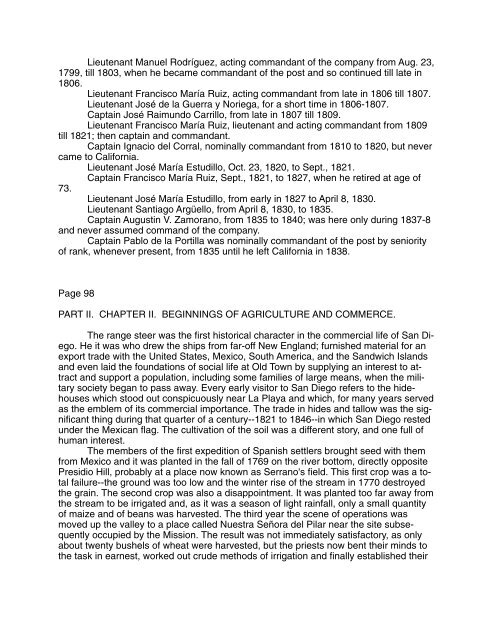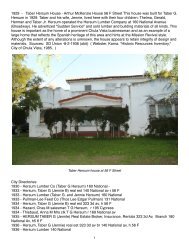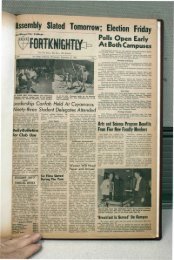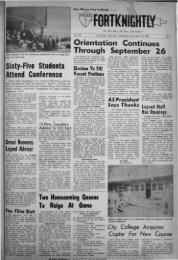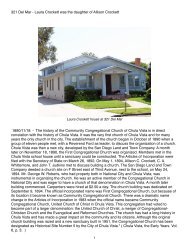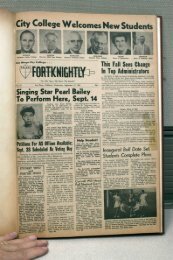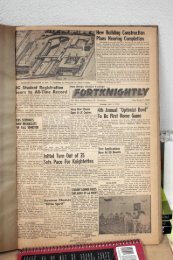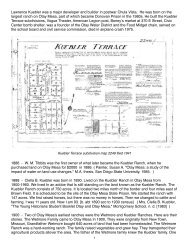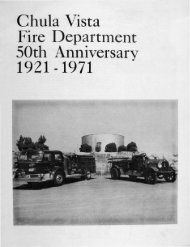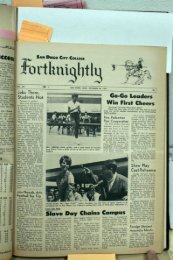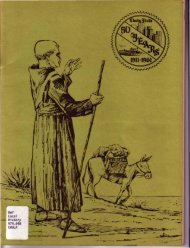doc241 - Schoenherr Home Page in Sunny Chula Vista
doc241 - Schoenherr Home Page in Sunny Chula Vista
doc241 - Schoenherr Home Page in Sunny Chula Vista
Create successful ePaper yourself
Turn your PDF publications into a flip-book with our unique Google optimized e-Paper software.
Lieutenant Manuel Rodríguez, act<strong>in</strong>g commandant of the company from Aug. 23,<br />
1799, till 1803, when he became commandant of the post and so cont<strong>in</strong>ued till late <strong>in</strong><br />
1806.<br />
Lieutenant Francisco María Ruiz, act<strong>in</strong>g commandant from late <strong>in</strong> 1806 till 1807.<br />
Lieutenant José de la Guerra y Noriega, for a short time <strong>in</strong> 1806-1807.<br />
Capta<strong>in</strong> José Raimundo Carrillo, from late <strong>in</strong> 1807 till 1809.<br />
Lieutenant Francisco María Ruiz, lieutenant and act<strong>in</strong>g commandant from 1809<br />
till 1821; then capta<strong>in</strong> and commandant.<br />
Capta<strong>in</strong> Ignacio del Corral, nom<strong>in</strong>ally commandant from 1810 to 1820, but never<br />
came to California.<br />
Lieutenant José María Estudillo, Oct. 23, 1820, to Sept., 1821.<br />
Capta<strong>in</strong> Francisco María Ruiz, Sept., 1821, to 1827, when he retired at age of<br />
73.<br />
Lieutenant José María Estudillo, from early <strong>in</strong> 1827 to April 8, 1830.<br />
Lieutenant Santiago Argüello, from April 8, 1830, to 1835.<br />
Capta<strong>in</strong> August<strong>in</strong> V. Zamorano, from 1835 to 1840; was here only dur<strong>in</strong>g 1837-8<br />
and never assumed command of the company.<br />
Capta<strong>in</strong> Pablo de la Portilla was nom<strong>in</strong>ally commandant of the post by seniority<br />
of rank, whenever present, from 1835 until he left California <strong>in</strong> 1838.<br />
<strong>Page</strong> 98<br />
PART II. CHAPTER II. BEGINNINGS OF AGRICULTURE AND COMMERCE.<br />
The range steer was the first historical character <strong>in</strong> the commercial life of San Diego.<br />
He it was who drew the ships from far-off New England; furnished material for an<br />
export trade with the United States, Mexico, South America, and the Sandwich Islands<br />
and even laid the foundations of social life at Old Town by supply<strong>in</strong>g an <strong>in</strong>terest to attract<br />
and support a population, <strong>in</strong>clud<strong>in</strong>g some families of large means, when the military<br />
society began to pass away. Every early visitor to San Diego refers to the hidehouses<br />
which stood out conspicuously near La Playa and which, for many years served<br />
as the emblem of its commercial importance. The trade <strong>in</strong> hides and tallow was the significant<br />
th<strong>in</strong>g dur<strong>in</strong>g that quarter of a century--1821 to 1846--<strong>in</strong> which San Diego rested<br />
under the Mexican flag. The cultivation of the soil was a different story, and one full of<br />
human <strong>in</strong>terest.<br />
The members of the first expedition of Spanish settlers brought seed with them<br />
from Mexico and it was planted <strong>in</strong> the fall of 1769 on the river bottom, directly opposite<br />
Presidio Hill, probably at a place now known as Serrano's field. This first crop was a total<br />
failure--the ground was too low and the w<strong>in</strong>ter rise of the stream <strong>in</strong> 1770 destroyed<br />
the gra<strong>in</strong>. The second crop was also a disappo<strong>in</strong>tment. It was planted too far away from<br />
the stream to be irrigated and, as it was a season of light ra<strong>in</strong>fall, only a small quantity<br />
of maize and of beans was harvested. The third year the scene of operations was<br />
moved up the valley to a place called Nuestra Señora del Pilar near the site subsequently<br />
occupied by the Mission. The result was not immediately satisfactory, as only<br />
about twenty bushels of wheat were harvested, but the priests now bent their m<strong>in</strong>ds to<br />
the task <strong>in</strong> earnest, worked out crude methods of irrigation and f<strong>in</strong>ally established their


